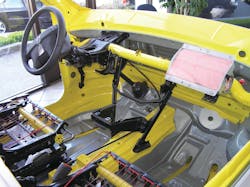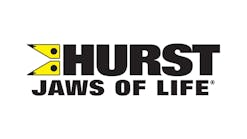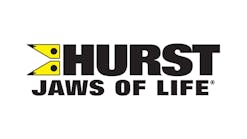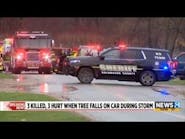University of Extrication: Interior Dash Rolling Evolution
SUBJECT: Dash and Instrument Panel Movement
TOPIC: Interior Dash Rolling Evolution
OBJECTIVE: Understand Procedures Necessary to Accomplish an Interior Dash Rolling Evolution
TASK: Given a late-model vehicle with the simulation of front seat occupants trapped, the rescue team shall move the dash, instrument panel, and other components away from the patients using the interior dash rolling evolution
When responders arrive at the scene of a severe head-on collision, the possibility of front-seat occupants being trapped is very real. If the impact forces are great enough or if the vehicle is one that has poor crashworthiness design, the dash, instrument panel, steering column, pedals, floorboard, and even the roof structure may collapse inward on those seated up front. One of the most common solutions to freeing these patients is for the rescue team to jack or roll the dash.
To accomplish this usually involves opening and/or removing front doors as well as making cuts in the structure of the vehicle along the lower area of the A-pillar. If the roof is still intact, the upper A-pillar must have a section cut out – “chunked” – to separate it from the roof structure. The two dash tie downs, which are explained later in this article, are uncovered and cut. At this point, a spreader tool is generally used to lift or “jack” the dash or a spreader or ram tool is used in a diagonal position across the door opening to ‘roll’ the dash.
Experienced rescue personnel can understand this next statement. We may encounter a situation where the position of the vehicle with the trapped occupants is such that a jammed door cannot be opened or access to the lower A-pillar may not be possible for some reason. For a rescue team that does not have the capability of cutting Advanced Steels such as Boron, the possibility exists that even if access is available, the team might not be able to make the required cuts into the ultra-high strength steels so conventional dash rolling or dash jacking can be accomplished. Well then, what options are left? It’s simple; roll or jack the dash but accomplish it from inside the vehicle.
The modification to our basic dash and instrument panel movement evolution being explained here is one that all rescue teams must practice and become proficient at. This method accomplishes the same dash and instrument panel movement but if confronted with a worst-case situation, does not require doors to be opened or even the lower A-pillar structure to be cut. The reason this technique is now possible and actually is a realistic alternative today is that most late-model vehicles have a dash and instrument panel structure that involves a horizontal dash support pipe unit and two dash tie-downs. This design was the theme of the December 2009 University of Extrication column and was described in detail at that time. The dash support pipe runs from A-pillar to A-pillar at about the level of the top hinge on the front doors. It is hidden behind the instrument panel and all of its trim covers and components such as the radio, heater and defroster controls. The dash tie downs are also hidden. They are on each side of the center “tunnel” structure that runs between the front bucket seats.
The interior dash rolling evolution involves working only from inside the vehicle. In an entrapment situation where this task is to be accomplished, personnel would most likely be using a power ram between the front bucket seats. Cribbing must be placed at the rear seat and floorboard area to form a solid base from which the ram can push off of. In addition, both dash tie downs must be uncovered and cut. With a solid push point base obtained, the ram is placed in position between the front bucket seats so it can push or ‘roll’ the instrument panel, dash, and all the attached components away from the front seat area. Although it is best if the doors are at least open fully, they could literally both be closed and this evolution can still be effective. Windshield glass can already be removed although it could still be in place during this entire assignment. The work that will be accomplished with a power ram pushes the windshield glass out of the way as the instrument panel moves. Also although it is best if both upper A-pillars are cut, they could remain attached and the assignment can still work if conditions are really bad for the rescue team. Most crews insist on cutting into the upper rail structure that is beneath the front fender, above the front wheel. This too is not necessary when rolling the dash from inside the vehicle. Think worst case where none of these normal cuts can be accomplished and with training, this interior dash rolling evolution might still work for you.
The ram operator must guide the plunger end or working end of the power ram into the plastic components of the instrument panel, aiming for the dash support pipe. Once the ram crushes through the instrument panel trim and all the stuff that it encounters, it will contact the dash support pipe and start pushing components away from the patients. As this happens, the entire dash and instrument panel structure will move forward, lift upward, and crush away from the front seat occupants.
All crews should be efficient at rolling or jacking a dash in the standard manner from outside the vehicle with doors open, the roof pillar cut, and strategic cuts made into the lower A-pillar. But, because we must be prepared for a worst-case scenario, crews must be capable of accomplishing an interior dash rolling evolution just in case.
TASK: Given a late-model vehicle with the simulation of front seat occupants trapped, the rescue team shall move the dash, instrument panel, and other components away from the patients using the interior dash rolling evolution.

Ron Moore
RON MOORE, who is a Firehouse contributing editor, recently retired as a division chief with the McKinney, TX, Fire Department and now serves with Prosper, TX, Fire Rescue. He self-published the Vehicle Rescue 1-2-3 training manual and serves as the forum moderator for the extrication section of Firehouse.com . Moore can be contacted directly at [email protected].






